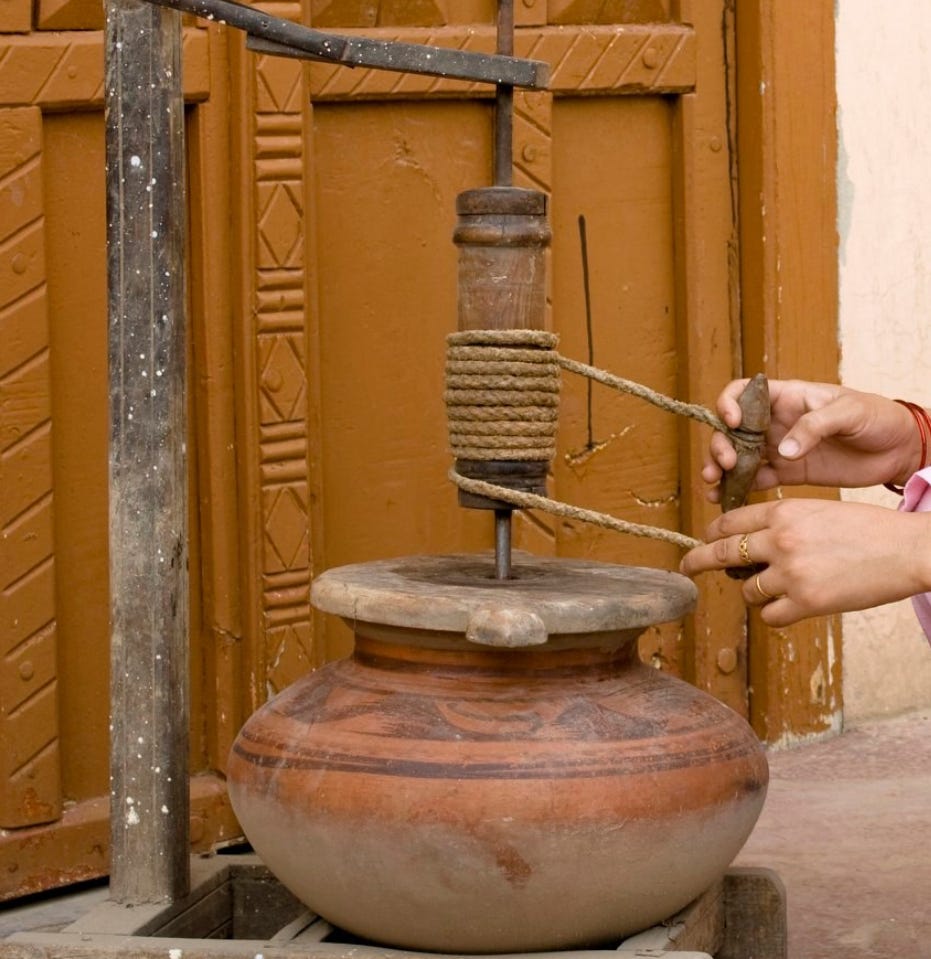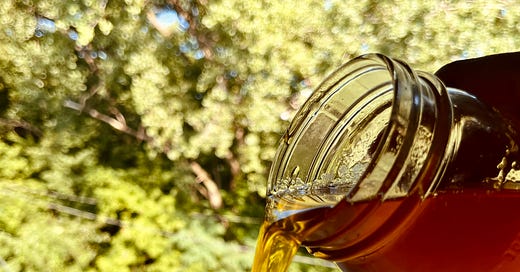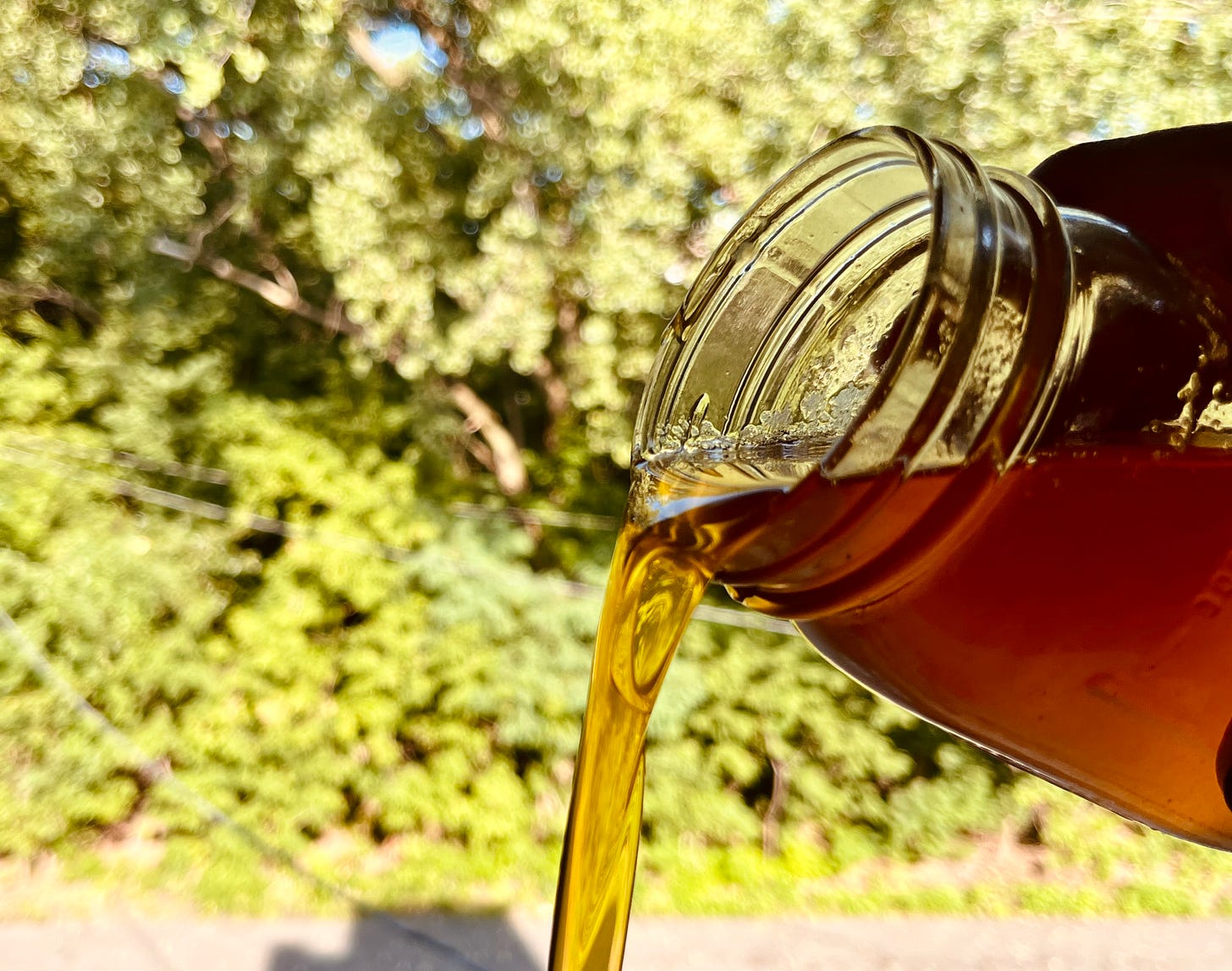Ghee is an enigma - an elixir of life to some, and a slow poison to others. To some, an explosion of flavor in an insipid plate of food; to others a blasphemous addition to an otherwise macro-balanced, calorie-perfected meal. To some, a commonplace pantry staple, to others a thing of mysticism, a connection to the divine. ‘Ghee’ is derived from the Sanskrit word ghṛ which translates to ‘to sprinkle’, likely originating from the ritualistic Hindu practice of sprinkling ghee on an auspicious fire. Ghee is an offering to the Gods - a pure, unadulterated, gift from Man selflessly sacrificed to his benefactor. Ghee is interestingly also cognate with the Greek word khristós (to rub or anoint) from which the English word Christ or Christen is derived.1 To quote R.K Narayanan, “Ghee is no doubt clarified butter. But it is also something more, in the same way wine is more than than just squeezed grapes.” And just as wine is symbolic to the Blood of Christ, ghee holds a mystical, divine symbolism to Hindus.
Somehow, despite being 7000 miles away from home, and a great many more from any semblance of religion in my personal life, ghee still has the ability to tug at my heartstrings.
a trip through time
you didn’t think I was done with nostalgia, did you?
One of my earliest memories is that of helping my Thatha (paternal grandfather) extract butter out of cultured cream. My grandmother would make her own yogurt - a common practice in India to this day - using fresh milk and some leftover yogurt used as a starter. Typically when the yogurt sets, usually after a day, the fatty cream from the milk seperates to the top. My grandmother would collect this cultured cream from each batch of yogurt in a jar in the fridge. When the jar of cream was full, it was time for ghee.
To procure ghee from this jar of cultured cream, the fats needed to be separated from the whey to first obtain butter. This was done through some classical physics - the concept of centrifugation. There are many ways to provide this centrifugal agitation. My grandparents, traditionalists as they were, used a wooden beater, a rope tied around a stool, and some good ol’ elbow grease.2 Because this was a task requiring considerable upper body strength, this chore fell to Thatha. The beater was held straight into the jar of cream using two pieces of rope. A third piece of rope was twisted around the beater a few times. Thatha would then hold both ends of the rope in each hand and firmly pull each end rapidly and alternately. This rhythmic motion would cause the beater to spin, churning the cream, et voila butter!

To be brutally honest, I cannot tell you how long this process took. To my child brain, it felt like 5000 hours but it also fit into the span of a single afternoon, so you do the math. My “job” was to sit next to Thatha, staring mesmerized into the whirlpool of churning cream, expectantly waiting for it to split into buttermilk and butter. I would then promptly stick my hand into the pot and grab a mouthful of the white subliminal clouds, and Thatha would always let me.
Once the butter was separated, it would be heated on a low flame until all the remaining milk solids brown and settle to the bottom. There you have it, Ghee! The golden liquid was poured out into jars. No part of this process goes to waste - the buttermilk was used to make chaas,3 even though my preference was to drink it straight out of the pot. The caramelized milk solids are actually a great source of protein and make for a delicious snack when mixed with rice and seasoned with salt.
ghee for the 21st century
When I decided to start making my own ghee I didn’t have 5000 hours or, to be honest even a whole afternoon, to churn butter. As it turned out, I didn’t need to spend all that time because ghee (and butter) quite effectively adapt to technology. If you are a visual learner, I have this whole process documented on my Instagram.
My method starts with 2 pints of heavy cream - because, try as hard as I might, I cannot separate cream from stabilized, emulsified milk. Heavy cream just works. I also tend to have leftover cream from my cooking and baking projects, which I tend to freeze and collect until there’s enough to make some ghee.
Next, is the exercise of culturing the cream. Strictly speaking, this is optional. You can separate butter from regular cream. Culturing is a close approximation of the ghee I grew up with, and as I have found, adds a complex nutty dimension to the final product - after all this is my cultured kitchen. I dump the heavy cream into my instant pot container, add in a tbsp of yogurt (plain), and set it to incubate in the “yogurt mode” on low heat for 10-12 hours.
The following morning, I place the whole container in the fridge. Cold temperatures make it much easier to separate the butter, so refrigerating is critical. I usually leave it in the fridge all day and get to it at night after dinner.
Next, we need to supply the centrifugal force. I replaced the rustic wooden beater set up, with my no frills food processor. You could use an electric mixer, a blender - pretty much anything that spins fast and can somewhat contain the inevitable spray. You can actually hear the butter split from the change in frequency of the burr of the blades. Once that happens, you separate all the butter from the milk, and wash it in a bowl of ice water to remove the excess buttermilk.
The last and final step - heat the butter low and slow. Your butter will start off looking like molten butter, then violently bubble, and then slowly but surely settle down into a golden still liquid and a mass of brown whey at the bottom - that’s when all the water has evaporated and you have managed to isolate the purest form of fat from milk. That golden liquid, is ghee.
are all ghee equal? - a process optimization
For most South Asian households, ghee is a pantry staple. Whether it’s store-bought, made from butter or cultured from milk fats, you would be hard-pressed to find a South Asian house that doesn’t have a jar of ghee in the back of their kitchen cabinets. South Asians use ghee for everything - a dollop of garnish to dull the spice of a curry, the fat component of sweetmeats and cookies, an antiseptic ointment for cuts and wounds, and an offering to the Gods poured on a ritual fire. When South Asians moved around to different parts of the world, so too did their ghee, slowly but surely establishing it’s identity as a superfood on the global culinary scene. Of all the new applications of ghee the one I find most fascinating is bulletproof coffee - a spoonful of ghee blended into black coffee, a purported go-to for those that swear by the keto diet.4
Regardless of how it’s put to use, this sudden popularity of ghee needs to be satiated by a high quality source. Whether it is the international aisle of Trader Joe’s (yes, they have ghee now) or the jar of cream your grandmother has been saving in the fridge, we need access to good ghee, and we need it now.
So, I being the ever-willing experimentalist, came up with this extensive study to figure out where you should get your ghee. My goal was to identify the following things - 1. Is there a difference between store-bought and homemade ghee; 2. Is cultured cream worth the hype; and 3. What’s the best bang for your buck?
The study looked at 4 different sources of ghee - 1. store-bought, 2. made from regular butter, 3. made from cultured butter, 4. made from heavy cream. All samples were tested on my guinea pigs aka test subjects aka friends and rated on a scale of 1-5 for aroma, looks, texture, and taste. I also asked them to rank their overall favorite. In the table below, I summarized all the scores for each ghee, as well as their cost/ 100 g (in USD).

final thoughts
All 3 of my participants noted a distinct upleasant aroma in the store-bought ghee which we chalked upto rancidity - fats stored on the shelves for a few months, even if sealed, are likely to go rancid over time. While not inedible, this impacted the overall experience and almost all of them could immediately identify the store-bought ghee from this distinct smell. While the regular butter was an incredibly affordable option, and produced a ghee with a distinct nutty and smokey aroma, participants noted that the aroma didn’t translate well into taste complexity - they felt it was one dimensional. In terms of preparation, this particular batch of ghee was hardest to control even on a low flame and nearly burnt, which probably explains the smokiness. Both cultured ghees rated pretty high for all participants which leads me to the reasonable conclusion that culturing does make a difference. The cultured butters had a nutty aroma without being too smokey, a grainy but melt-in-the-mouth texture, and a complex flavor profile that can only be the work of the microbes. Between the two options, it’s upto personal preference. While it seems like heavy cream produced the most expensive option, it also produced more than just ghee - I ended up with a quart of buttermilk from all the cream. Especially, if like me you tend to have leftover cream on hand this ends up being more affordable, and an excellent way to use up leftover cream with minimal waste. On the other hand, making ghee from scratch takes about 2 whole days, and while the active time is pretty low, there is some amount of planning required.
The bottomline - making your ghee regardless of which source you choose is almost certainly a better option, both for your tongue and your wallet. So whether it is for your bulletproof coffee or dal rice, go make some ghee. You won’t regret it. I hope this clarified a few things for you!
This video does a good job demonstrating the technique.
Chaas is a spiced buttermilk-based drink popular all over Indiaand possibly the rest of South Asia. In my house, we usually add curry leaves, black pepper, salt and cumin to the buttermilk in a preparation called Neer mor. Although, my personal preference is to wait for the buttermilk to go sour (for a couple of days) and then drink it plain, no additives.
Generally speaking bulletproof just sounds like some fatty coffee - people use coconut oil, ghee, butter, cream or coconut milk. I don’t know nearly enough about keto diets to say anything about this but the general idea is that drinking a fatty coffee improves satiety and enables you to prolong your fasting periods? Do your research if you’re going to try this out.








With the rise of olive oil, ghee is underrated I feel. Glad my mom included ghee in my diet.
Now it's clarified.